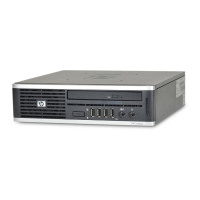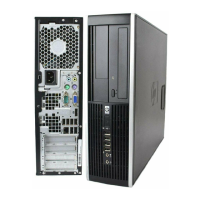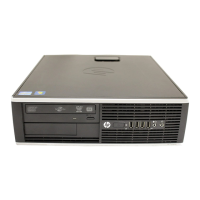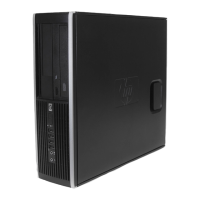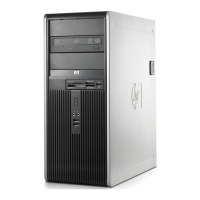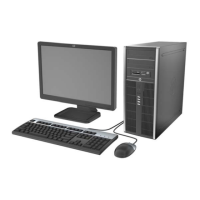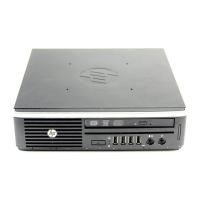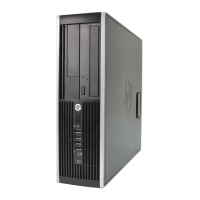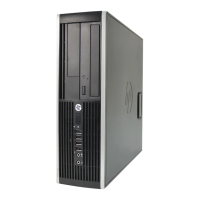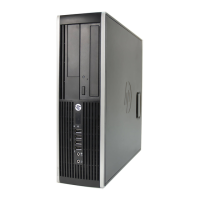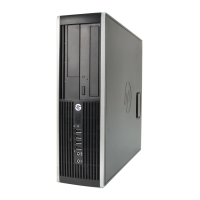

Do you have a question about the HP Compaq Elite 8000 CMT and is the answer not in the manual?
| Chipset | Intel Q45 Express |
|---|---|
| Audio | Integrated High Definition Audio |
| Power Supply | 240W or 320W |
| Processor | Intel Core 2 Duo, Core 2 Quad, or Pentium Dual-Core |
| Graphics | Integrated Intel Graphics or discrete graphics card options |
| Optical Drive | DVD-ROM, DVD-RW |
| Network | Gigabit Ethernet |
| Expansion Slots | 1 x PCIe x16, 2 x PCIe x1, 1 x PCI |
| Ports | USB 2.0, VGA, DisplayPort |
| Operating System | Windows 7, Windows Vista, Windows XP |
| Form Factor | Convertible Mini Tower (CMT) |
Explains the purpose and structure of the guide, including viewing options.
Lists external resources for more detailed information on components.
Describes the location and method for identifying the system's serial number.
Details the use of warnings, cautions, notes, and abbreviations within the document.
Provides a glossary of acronyms and abbreviations used throughout the manual.
Introduces the HP Compaq 8000 Elite Business PC series and chapter topics.
Lists the standard features included across all models of the HP Compaq 8000 Elite PCs.
Describes the underlying architecture and key components of the system.
Details the environmental, electrical, and physical specifications of the computers.
Introduces the processor and memory support for the systems and chapter topics.
Describes the Intel processors supported, their features, and installation details.
Details the DDR3 memory architecture, module types, and capacity support.
Outlines the topics covered in the System Support chapter, including bus architecture and resources.
Provides an overview of PCI 2.3 and PCI Express bus operations and specifications.
Explains system resources such as interrupts and DMA, and their management.
Describes the RTC and CMOS memory functions, including clearing CMOS settings.
Covers security, power management, system status, and thermal sensing functions.
Details system I/O maps and general-purpose I/O (GPIO) functions.
Introduces the various input/output interfaces covered in this chapter.
Describes the SATA and eSATA interfaces, including connector pinouts and setup.
Details the RS-232-C serial interface, including connector and baud rate support.
Explains the parallel interface modes (SPP, EPP, ECP) and connector details.
Covers the PS/2 keyboard and pointing device interface operations and connectors.
Describes the USB interface, port mapping, and connector specifications.
Details the HD audio subsystem, including codec, interfaces, and specifications.
Covers the NIC features, LED indications, and specifications for network connectivity.
Introduces the integrated graphics subsystem and upgrade options.
Explains the Intel GMA 4500 controller and its features for 2D/3D graphics.
Lists the standard 2D display modes and resolution/refresh rate support.
Details the procedure for upgrading the graphics controller via PCIe slots.
Describes the analog VGA and digital DisplayPort monitor connectors.
Introduces power supplies and general power/signal distribution methods.
Describes the external power supply used in the USDT form factor.
Details the internal power supply units for SFF and CMT form factors.
Explains system power control via the power button and external events.
Covers power management features, ACPI compliance, and power states.
Lists system board connector, indicator, and switch designators.
Introduces the BIOS functions, supported OS, and specifications.
Details the process for updating the system BIOS firmware.
Describes boot device order, network boot support, and memory detection.
Lists BIOS functions for system management and monitoring.
Explains SMBIOS data retrieval and structure types supported by the system.
Describes how the BIOS handles USB keyboards during POST and setup.
Covers Intel AMT functions and the alerts it can generate.
Introduces the appendix listing error codes and their probable causes.
Lists beep and power LED codes indicating system status and errors.
Details POST error messages, their codes, and probable causes.
Lists various system error messages and their corresponding probable causes.
Lists memory-related error messages and their probable causes.
Lists keyboard-specific error messages and their probable causes.
Lists printer-related error messages and their probable causes.
Lists video and graphics error messages and their probable causes.
Lists diskette drive error messages and their probable causes.
Lists serial interface error messages and their probable causes.
Lists modem communication error messages and their probable causes.
Lists system status error messages and their probable causes.
Lists hard drive error messages and their probable causes.
Lists hard drive error messages and their probable causes.
Lists video and graphics error messages and their probable causes.
Lists audio subsystem error messages and their probable causes.

